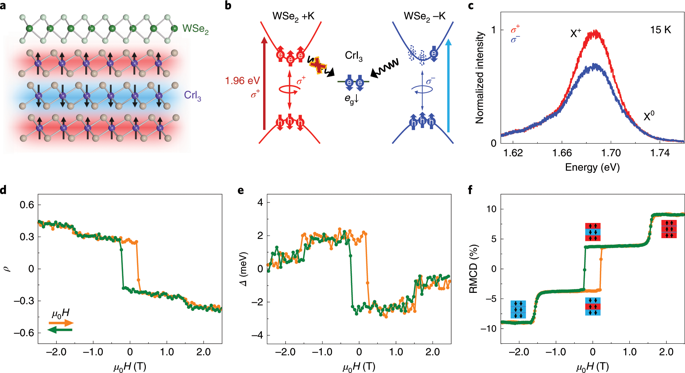Nature Nanotechnology ( IF 38.3 ) Pub Date : 2020-01-27 , DOI: 10.1038/s41565-019-0629-1 Ding Zhong 1 , Kyle L Seyler 1 , Xiayu Linpeng 1 , Nathan P Wilson 1 , Takashi Taniguchi 2 , Kenji Watanabe 2 , Michael A McGuire 3 , Kai-Mei C Fu 1, 4 , Di Xiao 5 , Wang Yao 6 , Xiaodong Xu 1, 7

|
Magnetic proximity effects are integral to manipulating spintronic1,2, superconducting3,4, excitonic5 and topological phenomena6,7,8 in heterostructures. These effects are highly sensitive to the interfacial electronic properties, such as electron wavefunction overlap and band alignment. The recent emergence of magnetic two-dimensional materials opens new possibilities for exploring proximity effects in van der Waals heterostructures9,10,11,12. In particular, atomically thin CrI3 exhibits layered antiferromagnetism, in which adjacent ferromagnetic monolayers are antiferromagnetically coupled9. Here we report a layer-resolved magnetic proximity effect in heterostructures formed by monolayer WSe2 and bi/trilayer CrI3. By controlling the individual layer magnetization in CrI3 with a magnetic field, we show that the spin-dependent charge transfer between WSe2 and CrI3 is dominated by the interfacial CrI3 layer, while the proximity exchange field is highly sensitive to the layered magnetic structure as a whole. In combination with reflective magnetic circular dichroism measurements, these properties allow the use of monolayer WSe2 as a spatially sensitive magnetic sensor to map out layered antiferromagnetic domain structures at zero magnetic field as well as antiferromagnetic/ferromagnetic domains at finite magnetic fields. Our work reveals a way to control proximity effects and probe interfacial magnetic order via van der Waals engineering13.
中文翻译:

范德华异质结构中的层分辨磁邻近效应
磁邻近效应对于操纵异质结构中的自旋电子1,2、超导3,4、激子5和拓扑现象6,7,8是不可或缺的。这些效应对界面电子特性高度敏感,例如电子波函数重叠和能带对齐。最近出现的磁性二维材料为探索范德华异质结构中的邻近效应开辟了新的可能性9,10,11,12。特别是,原子级薄的 CrI 3表现出层状反铁磁性,其中相邻的铁磁单层是反铁磁耦合的9. 在这里,我们报告了由单层WSe 2和双层/三层CrI 3形成的异质结构中的层分辨磁邻近效应。通过用磁场控制CrI 3中的单层磁化强度,我们表明WSe 2和CrI 3之间的自旋相关电荷转移主要由界面CrI 3层控制,而邻近交换场对层状磁层高度敏感。整体结构。结合反射式磁圆二色性测量,这些特性允许使用单层 WSe 2作为一种空间敏感的磁传感器,用于绘制零磁场下的分层反铁磁畴结构以及有限磁场下的反铁磁/铁磁畴。我们的工作揭示了一种通过范德华工程13控制邻近效应和探测界面磁序的方法。



























 京公网安备 11010802027423号
京公网安备 11010802027423号